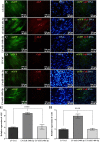Overexpression of MicroRNA-148b-3p stimulates osteogenesis of human bone marrow-derived mesenchymal stem cells: the role of MicroRNA-148b-3p in osteogenesis
- PMID: 31262253
- PMCID: PMC6604430
- DOI: 10.1186/s12881-019-0854-3
Overexpression of MicroRNA-148b-3p stimulates osteogenesis of human bone marrow-derived mesenchymal stem cells: the role of MicroRNA-148b-3p in osteogenesis
Abstract
Background: Mesenchymal stem cells (MSCs) are attractive choices in regenerative medicine and can be genetically modified to obtain better results in therapeutics. Bone development and metabolism are controlled by various factors including microRNAs (miRs) interference, which are small non-coding endogenous RNAs.
Methods: In the current study, the effects of forced miR-148b expression was evaluated on osteogenic activity. Human bone marrow-derived mesenchymal stem cells (BM-MSCs) were transduced with bicistronic lentiviral vector encoding hsa-miR-148b-3p or -5p and the enhanced green fluorescent protein. Fourteen days post-transduction, immunostaining as well as Western blotting were used to analyze osteogenesis.
Results: Overexpression of miR-148b-3p increased the osteogenic differentiation of human BM-MSCs as demonstrated by anenhancement of mineralized nodular formation and an increase in the levels of osteoblastic differentiation biomarkers, alkaline phosphatase and collagen type I.
Conclusions: Since lentivirally overexpressed miR-148b-3p increased osteogenic differentiation capability of BM-MSCs, this miR could be applied as a therapeutic modulator to optimize bone function.
Keywords: Lentivirus; Mesenchymal stem cells; MicroRNA-148b; Osteogenesis.
Conflict of interest statement
The authors declare that they have no competing interest.
Figures





References
-
- Abdallah B, Kassem M. Human mesenchymal stem cells: from basic biology to clinical applications. Gene Ther. 2008;15(2):1092. - PubMed
-
- Kassem M, Abdallah BM. Human bone-marrow-derived mesenchymal stem cells: biological characteristics and potential role in therapy of degenerative diseases. Cell Tissue Res. 2008;331(1):157–163. - PubMed
-
- Zhang W-B, Zhong W-J, Wang L. A signal-amplification circuit between miR-218 and Wnt/β-catenin signal promotes human adipose tissue-derived stem cells osteogenic differentiation. Bone. 2014;58:59–66. - PubMed
-
- Qureshi AT, Monroe WT, Dasa V, Gimble JM, Hayes DJ. miR-148b–nanoparticle conjugates for light mediated osteogenesis of human adipose stromal/stem cells. Biomaterials. 2013;34(31):7799–7810. - PubMed
-
- Tiago DM, Marques CL, Roberto VP, Cancela ML, Laizé V. Mir-20a regulates in vitro mineralization and BMP signaling pathway by targeting BMP-2 transcript in fish. Arch Biochem Biophys. 2014;543:23–30. - PubMed
Publication types
MeSH terms
Substances
LinkOut - more resources
Full Text Sources
Research Materials

